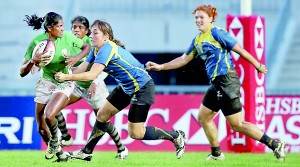Must take steps to improve women’s rugby
View(s):The news about the Sri Lankan Women’s Rugby can be considered as a development success though they did not bring home the bowl having reached the final.
The lasses did well on day one beating Korea and but had to be content having to play in the bowl segment. The girls did well to win the quarters against UAE and the semi-final against India. In the final they lost to Philippines by 22 points to 7 and were ranked 10th from the 16 teams that participated.
It is after 4 years that the Women’s team took part in an international event. This year they revived the game and with two sevens tournaments. From a background of not having played much competitive rugby the team I believe has done well and there is a need for more tournaments and matches to be played.
As the game took a backseat in recent times most of the corporates that took part reduced their support. At present the ladies that play are mostly affiliated to the services with a few clubs sprouting in the outstations. However it may look feasible on the short run to see whether some matches can be played during the Mercantile Sevens.
On the long run there can be an effort to promote the game along with the Mercantile Rugby Football Association. Another option would be to have a women’s sevens league games played prior to some of the key club games. There can be around three or four matches played say once or twice a month starting at around 15.30 hours before a key club game. This can also be done at a provincial level starting with the Central Province and the Western Province with matches being played before a key game. The profile of the team comes from outstation. They can be used to spread the message of rugby. There are few or none of the team that are from those affiliated with the elitist rugby clubs or schools. It is surprising when at most club and school matches you see many knowledgeable vociferous supporters are seen shouting at players as well as referees. This week it would be another opportunity for the Sri Lanka Sevens team to better their plate win in Shanghai as they take part in the Mumbai Sevens.
Curtains were drawn on the fifteen a side game with the Clifford Cup final played in Bogambara between league champs Havelock’s and defending winners of the Knockout Kandy Sports Club. The crowds that presented themselves for the final were more than that was seen at games in Colombo. The final however was lost in coverage before as well as after the game with more interest centered on the T20 World Cup Final. Who will wear the “dunce hat” for taking the decision in a council that has many sitting and few working?
 Kandy beaten in the league came back strong to beat Havelock Sports Club by ten points to five. Havelock’s failed to make it a double while the cup went to Nittawela for the 19th time. The game was attended by a reasonable crowd was played on a rain soaked pitch that effected both teams and did not do justice to a final.
Kandy beaten in the league came back strong to beat Havelock Sports Club by ten points to five. Havelock’s failed to make it a double while the cup went to Nittawela for the 19th time. The game was attended by a reasonable crowd was played on a rain soaked pitch that effected both teams and did not do justice to a final.
One thing that happened this year was bringing foreign referees as some thought that was the right thing to do. Whether it has helped the game and the effects on the future cannot be measured and will always be a subjective opinion. One thing that has surfaced after the semi-final as well as the final is that there is bashing of the foreign referees too. This happened a after the semi-final as well as the final where influential supporters hurled verbal abuse confronting the referees after the match. Crowds too keep chanting the usual hints of dissatisfaction. That however is something that you can do nothing about. When these are the result of body language of the officials there is something to worry. There was no acceptance of the local referees and now it appears that there is no acceptance of the visiting referees. If so where is the real problem? Is it with the inability to understand the interpretation and application of the laws? A point of fact is that spectators keep shouting holding on and criticizing the referee that players are penalized for the tackler for releasing. A point of hope was when I heard Isipathana coaches Shamly Nawaz and Bandula Mallikaarachchi explaining to some of the spectators that the sequence * Tackler to release tackled player immediately * Tackled player to release or pass ball immediately. *. Assist tacklers to release tackled player immediately. * Arriving players from both sides to enter through the gate * Ball winning team should not prevent a contest by “sealing off” * Arriving players should not be obstructed. It does not look that bad if those that are looked up as role models take the message across.
Vimal Perera is a former Rugby Referee, coach and Accredited Referees Evaluator IRB
comments powered by Disqus

